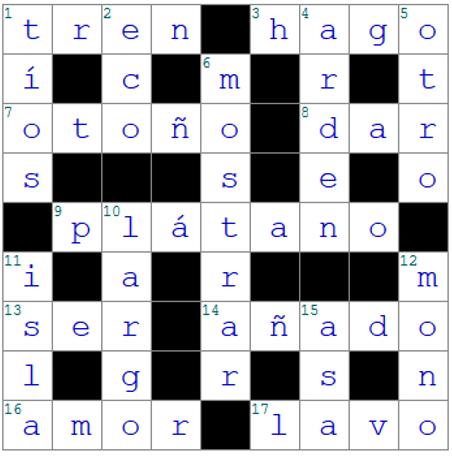
3 minute read
Spanish Skills Crossword
Crossword
solution posted in next month’s edition
Advertisement
Across
1 some; something 3 (he) smokes 7 bear 8 (he) travels 9 pains 13 (she) runs 15 river 16 wave, undulation 17 (I) create
Down
1 love 2 balloon 4 grape 5 to tie 6 airplanes 10 mistake 11 eight 12 wolf 14 net, mesh of string, cord or rope
Last month’s crossword solution:

The National Symphony Orchestra of Mexico
from the Path to Citizenship series article and images from Wikimedia
The National Symphony Orchestra (is the most important symphony orchestra in Mexico. With its origins traced back as 1881, it is the second-oldest symphony orchestra in the First period American continent along with the Boston Symphony Orchestra. The orchestra does not have a permanent venue but The orchestra has its roots back in 1881, when Alfredo Bablot, performs regularly in the Grand Hall of the Palace of Fine Arts director of the Music Conservatory (founded July 1, 1866) initi(Palacio de Bellas Artes) in Mexico City. ated the Conservatory Orchestra. When Bablot died, he was replaced by Carlos J. Menéses. In 1902 the orchestra had little Not to be confused with the Orquesta Sinfónica del Estado de support from the government of Porfirio Díaz, but it suspended México (OSEM) or Symphony Orchestra of the State of Mexico, its activities in 1913, two years after Díaz's fall, because of the founded in 1971, the National Symphony Orchestra of Mexico, general instability in the country during the Mexican Revoluas a branch of the Instituto Nacional de Bellas Artes, was creat- tion. ed by presidential decree of Miguel Alemán on 18 July 1947, under the name of National Conservatory Symphony Orchestra. Second and third period Before that, however, there was a predecessor orchestra known as the Symphony Orchestra of Mexico (September 2, 1928 March 8, 1949), a nonprofit organization founded and conducted by Mexican composer, conductor, teacher, journalist and visionary arts leader Carlos Chávez. On 1 August 1947, Chávez appointed Blas Galindo as the new director of the National Conservatory, official seat of the new orchestra. Chávez reports that the National Symphony Orchestra gave its first official performance on 30 October 1947 at the Palace of Fine Arts, under the baton of Eduardo Hernández Moncada, its first music and artistic director. Another decree on April 25, 1949, changed the name of the ensemble to National Symphony Orchestra (Orquesta Sinfónica Nacional or OSN); first, to emphasize its professional character - it had the best musicians in the country - and to avoid confusing it with a student ensemble, despite Chávez's having from the very beginning considered the orchestra a national symphony, linked in some aspects to the most important music education institution, the National Conservatory; and second, Chávez wanted to highlight that “a National Symphony, by definition, is a State institution,” and the government had recognized the need to support an institution of public interest.
History of the Orchestra
The social context that Mexico was living during the beginnings of the 20th century made the task of creating an orchestra difficult, so there were several attempts to form a national symphony orchestra.
After Gen. Venustiano Carranza took over the national government's seat back to Mexico City in 1915, the orchestra took the name of National Symphony, and depended from the Bellas Artes bureau, and its director during this period was Jesús Acuña, followed by composer Manuel M. Ponce but he declined and the orchestra suspended the concert seasons. Later, composer Julián Carrillo, who was a very important figure in music history worldwide, was appointed as the Music Conservatory director, and took up the project for an orchestra again, and depended from the Conservatory, but because of lack of financial support from the government, the orchestra again finished its activities in 1924.
In 1928, the Mexican Symphony Orchestra was created, but the name changed shortly to Symphony Orchestra of Mexico (Orquesta Sinfónica de México) . This orchestra is more related to the current orchestra. Carlos Chávez was appointed as its first conductor, but it lacked of any financial support, besides that the orchestra wasn't being well administrated by the city's musician syndicate of that time. While Chávez conducted the orchestra, it meaning a flourishing period for the orchestral music in the country.
A private patronage was established and the orchestra could give its first concert. The date was September 2, 1928, and the place, the Iris Theatre. With 103 musicians on stage, the program included Debussy's Ibéria Suite, Tello's Sonata Tragica, Tchaikovsky´s Piano Concerto No. 1 in B-flat minor with Vilma Erenyi as soloist, and Strauss's Don Juan.

